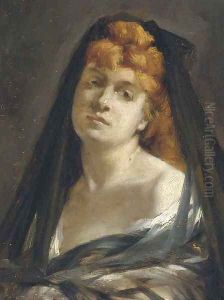Leon Francoise Comerre Paintings
Leon Francois Comerre was a distinguished French painter born on October 10, 1850, in Trélon, Nord, France. He was renowned for his portraits, historical, and allegorical scenes, imbuing his works with a characteristic vibrancy and precision that set him apart from his contemporaries. Comerre's artistic journey began at the École des Beaux-Arts in Lille, where he first honed his skills before moving to Paris to further his studies under the tutelage of Alexandre Cabanel, a prominent figure in the French academic painting tradition. His talent was recognized early on when he was awarded the prestigious Prix de Rome in 1875, a scholarship that allowed him to study in Rome, a city that greatly influenced his artistic development.
During his time in Rome, Comerre was exposed to the rich tapestry of Italian Renaissance art, which deeply influenced his style and thematic choices. Upon returning to Paris, he quickly established himself as a sought-after portraitist and painter of historical and mythological scenes. His works were characterized by their luminous color palette, detailed depiction, and the sensual elegance of his figures, which often reflected the romantic and idealistic tendencies of the time.
Comerre's success was not confined to France; his paintings were exhibited internationally, including at the Salon in Paris, where he received numerous awards and accolades. His reputation as a master painter attracted a wealthy clientele, including aristocrats and prominent figures of the Belle Époque, who sought his skill for their portraits. Beyond portraiture, his allegorical and mythological works were celebrated for their beauty and intricate symbolism, showcasing his versatility and depth as an artist.
Leon Francois Comerre's legacy is marked by his contribution to the French academic tradition, and his works continue to be admired for their beauty, technical skill, and the luminous quality of their execution. He passed away on October 20, 1916, in Le Vésinet, near Paris, leaving behind a body of work that celebrates the human form and the artistic heritage of his time. His paintings remain in collections worldwide, attesting to his enduring appeal and significance in the history of art.
